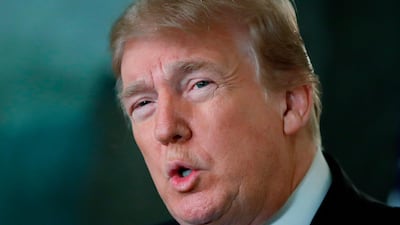Either some kind of schizophrenia has made inroads into Donald Trump’s character or the man behind "the art of the deal" is combining pragmatism with improvisation in his foreign policy vision. Or, perhaps, Mr Trump believes he is smarter than any member of his administration and does not need to consult anyone before he proclaims a completely different policy line from one he has previously espoused.
Perhaps Mr Trump is prematurely revealing the features of a new US policy in order to take some credit for what is to come. A few weeks ago, Mr Trump announced, without warning, his willingness to meet North Korea after months of mocking Kim Jong-un. This may have encouraged him to pursue these shock tactics in foreign policy. Two days ago, Mr Trump declared that the US would withdraw from Syria "very soon", to the surprise of all those who have followed US policy declarations. So was Mr Trump's shock announcement a gaffe or have geopolitical developments and realpolitik now brought about a new strategy in the region?
Mr Trump made his Syria announcement while addressing workers in Ohio. The context of his populist speech was lamenting Washington's squandering of trillions of dollars on wars in the Middle East, in the wake of the visit by the Saudi Crown Prince Mohammed bin Salman, whose priority was Yemen.
In Yemen, the US can put Iran on the defensive. Furthermore, defending the flow of oil from the Gulf, a permanent American red line, can justify US military intervention. The Houthi missile strikes on Saudi Arabia could trigger an American push to alter the current stalemate. Mr Trump can use the oil argument to convince his base of the need to head-off Iran's scheming in Yemen. Mr Trump is also leading a revival of the strategic relationship with Saudi Arabia, and has felt during Prince Mohammed's visit the clarity of the Yemeni priority for Saudi national security.
The pushback against Iran will not be confined to Yemen. The US focus following the putative move away from Syria will be on Iraq, where the modified political behaviour of the leaders in Baghdad has been received well in Washington. According to the new thinking in the US, heading-off the Iranian crescent should cover both Syria and Iraq.
But how could the policy of the Trump administration have evolved from seeing Syria as the main arena for containing Iran’s expansion to apparently entrusting Russia with the responsibility for curbing Iran?
"Look for Steve Bannon," says an informed observer familiar with the thinking of Trump administration officials. Bannon was let go because of the revelations in Fire and Fury, but his isolationist instincts still influence Mr Trump. What happened, according to the source, is the triumph of Bannon's strategy sans Bannon.
Since Mr Trump took office, the administration has stumbled between two conflicting visions, and many White House staff have been victim of the dissonance. Bannon's vision had identified three key challenges: China, Iran and Turkey. In this vision, Russia is not a challenge but a side show, as the source put it, with Vladimir Putin seen as someone the US can do business with. "What we see now is the translation of Bannon's vision ... Fire and Fury destroyed Bannon but not his vision," said the observer.
The White House faction espousing this believes a deal with the Russians is possible, especially with regard to containing the short-term challenges represented by Iran and Turkey. Therefore, the diplomatic violence with Russia – with the expulsion of diplomats – must not be seen in isolation from gestures such as Mr Trump congratulating Mr Putin for his election victory. Indeed, this is not random, but reflects Mr Bannon's strategy and the orientations of the new national security and state department appointees, John Bolton and Mike Pompeo.
Sources close to the outgoing national security adviser, H R McMaster, said he had been replaced for two main reasons: first, Mr Bolton is a tough civilian, the sources say, who understands very well the intersection of politics and the military game. Second, it was Gen McMaster who had persuaded Trump to focus on Syria. He belonged to the team that wanted a deeper US involvement in Syria to challenge Iran and contain Russia. Those were the people who were replaced, because the other faction prevailed, as Mr Trump's announcement proves.
Mr Trump linked the announcement to defeating ISIL and this could well be a declaration of the end of the US war against the group in Syria. Iraq is a more important theatre for the Americans when it comes to preventing ISIL from regrouping, while Syria can be handled by other powers.
On the surface, this appears to be an American reversal in Syria and a serious blow to US policy, already notorious for its contradictions and abandonment of allies. Not long ago, the Trump administration and the US top brass had laid down the roadmap for Syria, yet now Mr Trump has completely upended it.
Some commentators insist the pushback against Iran remains at the heart of US strategy. The goal now may be to challenge Iran in Yemen and Iraq, in parallel with economic measures and withdrawal from the nuclear deal. Mr Trump chooses his battles, one source in Washington said that “regime change in Iran is one of his priorities.”
The equation with Russia, according to the source, is this: “We will leave Bashar Al Assad to you in return for not standing in our way with Iran.” However, this equation does not mean that the US will leave the arena completely open to Iran and Hezbollah in Syria. Rather, the US will want to increase the cost of the intervention there by stepping up the war of attrition against them in Syria and beyond.


